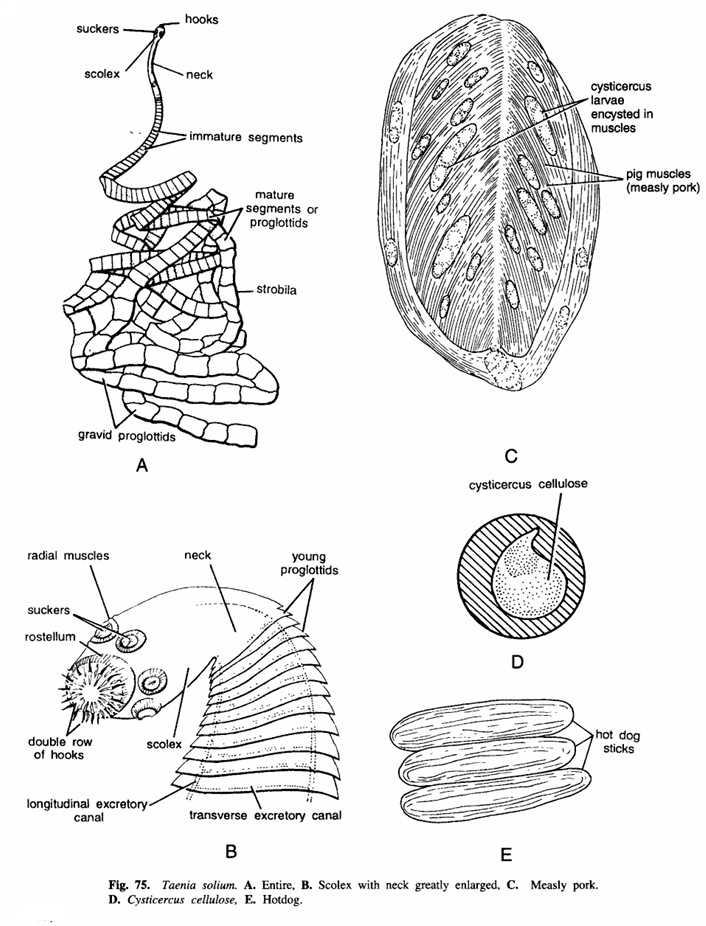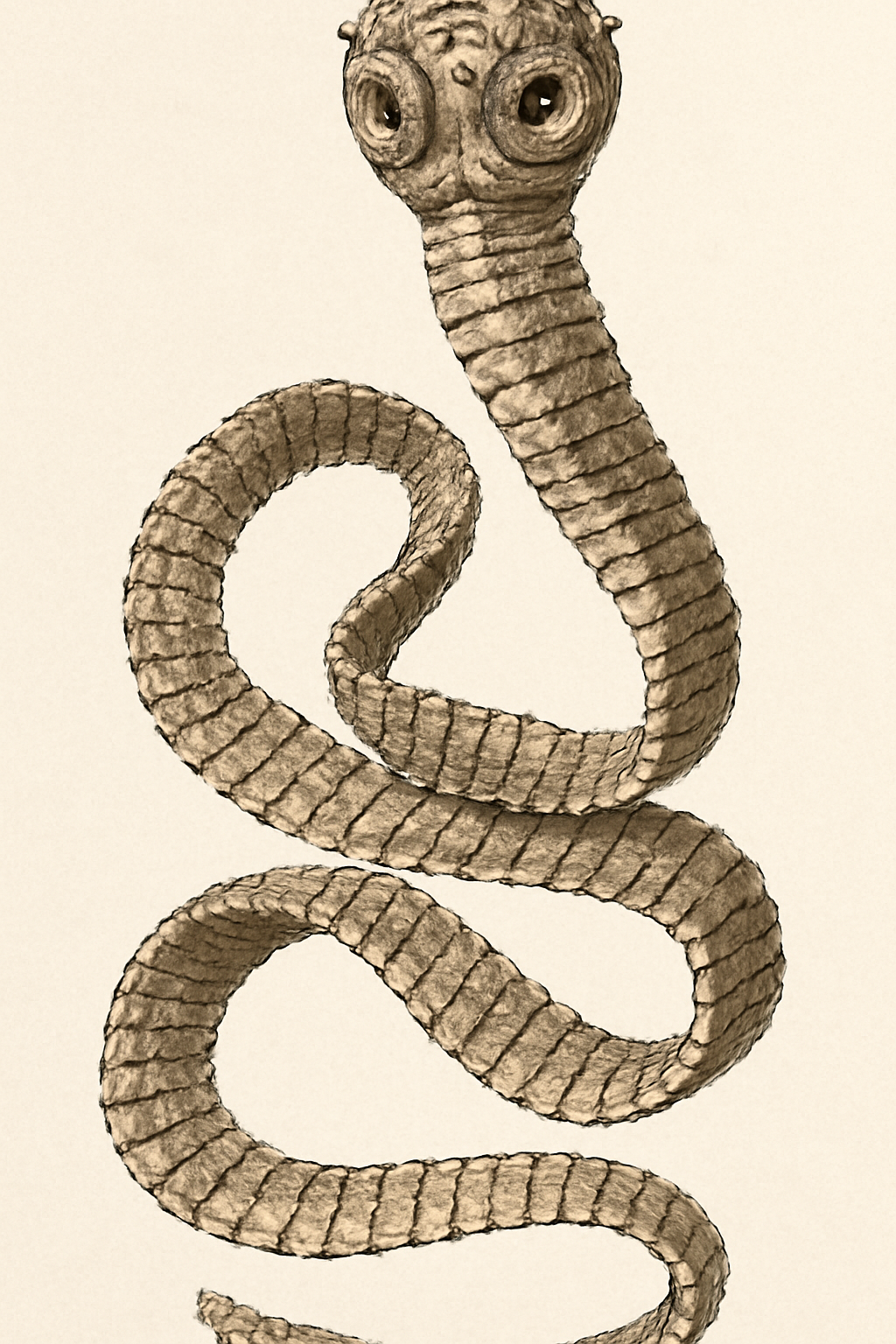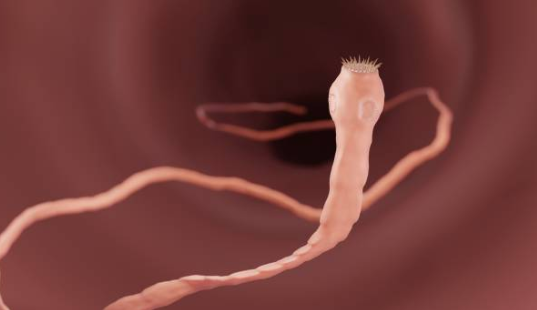Introduction
Taenia solium, commonly referred to as the pork tapeworm, is a parasitic flatworm of great medical and veterinary significance. It belongs to the phylum Platyhelminthes and class Cestoda. This tapeworm primarily infects humans as the definitive host and pigs as the intermediate host. Taenia solium causes two distinct diseases: taeniasis, an intestinal infection by adult tapeworms residing in humans, and cysticercosis, a tissue infection caused by larval cysts developing in pig or human tissues. This parasite is a major cause of neurological disease worldwide, including neurocysticercosis, a leading cause of epilepsy, especially in low-income regions where sanitation and pork cooking standards are suboptimal.
Classification of Taenia solium
| Classification Level | Name | Characteristic |
|---|---|---|
| Kingdom | Animalia | Multicellular, eukaryotic heterotrophs |
| Phylum | Platyhelminthes | Flatworms with bilaterally symmetrical, unsegmented bodies |
| Class | Cestoda | Parasitic tapeworms with segmented ribbon-like bodies |
| Order | Cyclophyllidea | Tapeworms with four suckers and armed rostellum |
| Family | Taeniidae | Tapeworms parasitizing vertebrates with complex lifecycles |
| Genus | Taenia | Cestodes with scolex armed with hooks |
| Species | solium | Pork tapeworm infecting humans and pigs |

Habit and Habitat
Taenia solium is an obligate endoparasite, spending its adult phase primarily in the small intestine of humans. The tapeworm attaches to the intestinal mucosa using its specialized scolex equipped with four suckers and a rostellum bearing rows of hooks. Within the intestine, it absorbs nutrients across its tegument, as it lacks a digestive tract.
The intermediate habitat involves pigs, which ingest eggs or proglottids passing in human feces. Within pig tissues, the eggs hatch into oncospheres that penetrate intestinal walls and migrate to form cysticerci—fluid-filled larval cysts—primarily in muscles but sometimes in other tissues. Humans can acquire cysticercosis by ingesting eggs through contaminated food or water, where cysticerci develop in tissues including the central nervous system.
Geographical Distribution
Taenia solium has a worldwide distribution but is most prevalent in regions where pig farming coexists with poor sanitation and hygiene, mainly in Latin America, sub-Saharan Africa, and parts of Asia. It is endemic in rural, resource-poor areas with limited access to clean water and proper sanitation facilities. Globalization and migration have introduced the parasite to other regions, including parts of Europe and North America, especially in immigrant populations from endemic countries.

General Characteristics
- Commonly called as Pork tapeworm.
- Body divided into scolex, neck, immature, mature and gravid segments.
- Scolex serves as hold-fast organ.
- Taenia solium contains 4 suckers and a rounded rostellum. Suckers contain radial muscles.
- Rostellum at its base contains double row of 28 to 32 hooks.
- Neck region is area of proliferation. Mature segment contains well developed hermaphrodite genital organs. Gravid segments contain branched uterus filled with onchospheres. ,
- Life-cycle includes two hosts (i) man as definitive host and (ii) pig as intermediate host. Longitudinal and transverse excretory canals are seen in all segments. In villages man deficates in the open field.
- Pig eats contaminated human faeces containing onchospheres and becomes infected.
- Onchospheres or hexacanth larvae develop into Cysticerous larvae or bladder worm called as Cysticercus cellulose, which encyst in thigh, chest, shoulder muscles of the pig.
- Such muscle is called as Measly pork.
- When man eats inadequately cooked hot dog or measly pork, it becomes infected and Taenia solium develops into adult in the intestine.
Taenia solium is an opaque white or creamy flatworm with a long, dorsoventrally flattened, ribbon-like body which may range from 2 to 8 meters in length in the adult stage. Its anterior scolex, about 1 mm in diameter, is uniquely equipped with four large suckers and a rostellum armed with two rows of hooks (22-32 in number), which facilitate attachment to the human intestine.
The body, known as the strobila, comprises hundreds of proglottids or segments. These segments mature as they move posteriorly, ranging from immature, mature (hermaphroditic with fully functioning male and female reproductive systems), to gravid proglottids filled with fertilized eggs. The eggs are spherical, measuring 35–42 µm, and are passed out in the feces. The tegument or body covering has microtriches that increase surface area for nutrient absorption and immune evasion.
Taenia solium lacks a digestive system and instead relies completely on absorbing predigested nutrients from the host. Its reproductive system ensures prolific egg production, with each gravid proglottid producing thousands of eggs.

Special Features
- It causes various diseases in man like anaemia, secondary anaemia, eosinophilia, diarrhoea, haemorrhage, abdominal pain, nausea and insomnia, etc. Upto 13% eosinophilia is caused by it. It also causes metabolic disturbances in the host.
- Preventive measures : The hot dogs are very common in affluent. Eating of measly pork should be avoided. The pig flesh should be examined for bladder cysts and contaminated flesh should not be allowed for marketing. Inadequately cooked pork should not be allowed and thus infection of Taeniasis can be prevented.
- Scolex Adaptation: The scolex armed with hooks and suckers provides a firm attachment to the intestinal wall, essential for survival in the dynamic gastrointestinal environment.
- Proglottid Segmentation: The segmented body allows continuous growth and reproduction, with mature segments detaching and spreading eggs into the environment.
- Lifecycle Complexity: A two-host lifecycle involving humans (definitive) and pigs (intermediate), requiring fecal-oral transmission and ingestion of undercooked pork or eggs.
- Human Cysticercosis Risk: Accidental ingestion of eggs by humans, leading to cysticercosis, in particular neurocysticercosis, a serious neurological condition causing seizures.
- Anaerobic Metabolism: Adapted to survive in the low-oxygen intestinal environment through anaerobic metabolic pathways.
- High Reproductive Capacity: Rapid multiplication through egg production ensures persistence and widespread infection.
Identification
Identification of Taenia solium is primarily based on morphological and microscopic examination:
- Adult Worm: Recognition through scolex morphology; presence of four suckers and a rostellum with two rows of hooks distinguishes it clearly from Taenia saginata, the beef tapeworm.
- Eggs: Fecal examination reveals characteristic eggs, spherical with a thick embryophore, although eggs of T. solium and T. saginata are indistinguishable microscopically.
- Proglottids: Examination of proglottids distinguishes T. solium by size, shape, and number of uterine branches (7-13 per side).
- Molecular Diagnostics: PCR and serological tests augment identification, especially in clinical settings for cysticercosis.
Life Cycle Summary
The lifecycle begins when humans pass gravid proglottids containing eggs into the environment through feces. Pigs ingest contaminated materials, where the eggs hatch to oncospheres that penetrate pig intestinal lining and form cysticerci in muscles. Humans consume undercooked pork containing cysticerci, which develop into adult tapeworms in the intestine. Additionally, humans can ingest eggs leading to cysticercosis.
Health and Economic Impact
Taenia solium is responsible for substantial health burdens due to its association with taeniasis and cysticercosis. Neurocysticercosis is a leading cause of adult-onset epilepsy in endemic regions, and infections cause morbidity and occasionally mortality. Economically, infected livestock decrease in value due to condemnation of infected meat. Control programs focus on sanitation improvement, mass drug administration, and cooking pork thoroughly.
Conclusion
Taenia solium is a complex zoonotic parasite that causes significant public health and veterinary challenges globally. Its unique biological adaptations, complex lifecycle, and high reproductive potential ensure its survival and persistence. Knowledge of its biology, lifecycle, and epidemiology is critical to managing and controlling infections in humans and pigs.
References
- https://en.wikipedia.org/wiki/Taenia_solium
- https://microbenotes.com/taenia-solium-habitat-structure/
- https://www.canada.ca/en/public-health/services/laboratory-biosafety-biosecurity/pathogen-safety-data-sheets-risk-assessment/taenia-solium.html
- https://www.cdc.gov/dpdx/taeniasis/index.html
- https://animaldiversity.org/accounts/Taenia_solium/
- https://www.biologydiscussion.com/invertebrate-zoology/phylum-platyhelminthes/taenia-solium-habitat-structure-and-life-history/28918
- https://pmc.ncbi.nlm.nih.gov/articles/PMC2769216/
- https://neupsykey.com/taenia-solium-biological-characteristics-and-life-cycle/
- https://www.sciencedirect.com/topics/medicine-and-dentistry/taenia-solium
- https://www.who.int/publications/i/item/9789240076334
- https://pmc.ncbi.nlm.nih.gov/articles/PMC3587748/
- https://edurev.in/t/314888/Platyhelminthes-Taenia-Solium
- https://pmc.ncbi.nlm.nih.gov/articles/PMC6168177/
- https://pmc.ncbi.nlm.nih.gov/articles/PMC5957458/
- https://pmc.ncbi.nlm.nih.gov/articles/PMC3103219/
- https://www.sciencedirect.com/science/article/pii/S0022510X20303944
- https://www.msdmanuals.com/professional/infectious-diseases/cestodes-tapeworms/taenia-solium-pork-tapeworm-infection-and-cysticercosis
- https://upcollege.ac.in/Upload/econtent/1198.pdf
- https://www.sciencedirect.com/science/article/pii/S1201971223000486
- https://unlimithealth.org/ntds/pork-tapeworm-taenia-solium/
